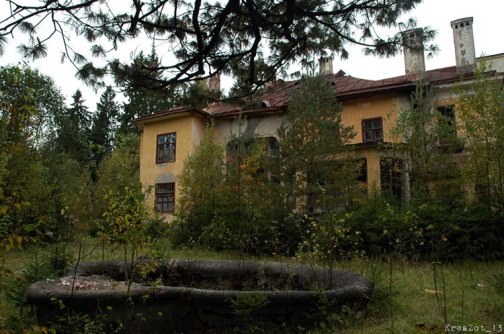

Location: near Pesochniy village, Leningrad Oblast Map
The famous surname Faberge is strongly associated with jewelry,
which is not surprising, because the products of this family have
gained fame all over the world. And there is no doubt that the
representatives of the family had an innate craving for beauty,
which was expressed, for example, in the famous dacha of Agathon
Faberge in Levashov.
At the beginning of the turbulent 20th
century, the famous jeweler Carl Faberge acquired a dacha in
Levashov, not far from Aspen Grove. In 1907, he donated this country
house to his son, Agafon Karlovich Faberge, who almost immediately
began to rebuild it. Initially, the building in the style of an
English cottage was built according to the project of architect Karl
Schmidt. The new owner decided to change its appearance, and the
renovated dacha in Levashov appeared in all its glory after just one
year.
Agathon Faberge greatly increased his residence and brought here his collection of jewelry, paintings, old carpets and other art objects. In fact it became known as a "small Hermitage" as a reference to the Winter Palace (Hermitage) of the Russian Tsars.. Although Faberge estate is considered a historic building nothing was done to preserve the former residence of the Faberge family. It is surprising if you take in consideration that this is one of the few intact examples of Russian modern architecture. It seems that the whole building is made up of broken lines. There is no straight angles in the windows, staircases and even outside walls. Every line of the house is elegant and curved. It is a shame that the government completely ignores this beautiful and fascinating place. The sign on the entrance door prohibits trespassing and threatens with guard dogs. However aside of a single watchman they say lives in the area (probably an urban legend), there is no sign of any serious security measures. It is surprising that almost all glass windows are still intact.
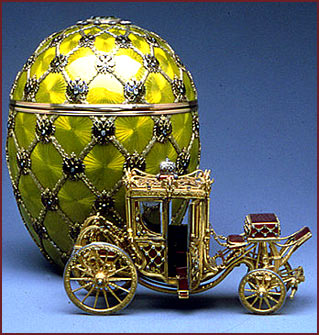
Marble Staircase

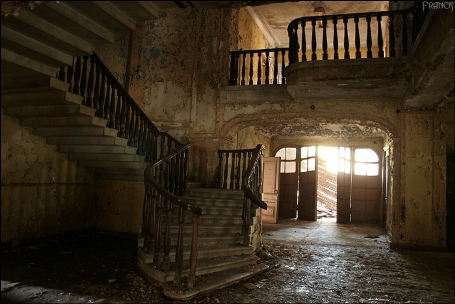
Marble Staircase was the centre piece of the Faberge Residence. It was the main stair case in the house and today it is the best preserved in the estate. So if you want to get on the second floor you should probably use this one instead of any others in the house. The ceiling here was made of glass and allowed natural light to illuminate this part of the house. Unfortunately most of the glass is covered by soil and plants that collected here over past decades of neglect. But you still can use your imagination to picture how magnificent it looked just a century ago. Today it is dark and gloomy, but before the Soviet Revolution it was the brightest room in the house.
Second Floor and ceiling over the Marble Staircase
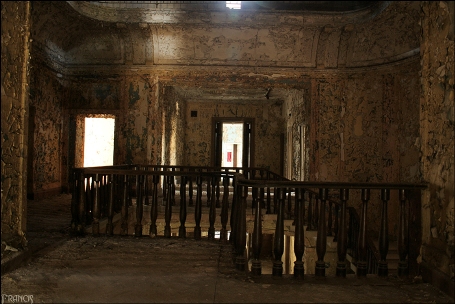
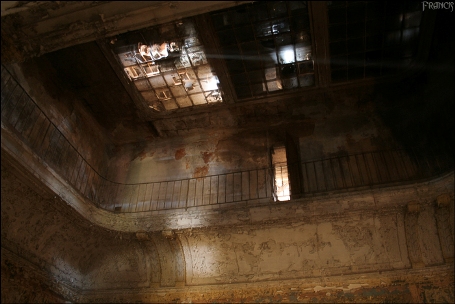
Faberge Estate or Dacha gets its new collection of carpets before owners move in (circa 1908)
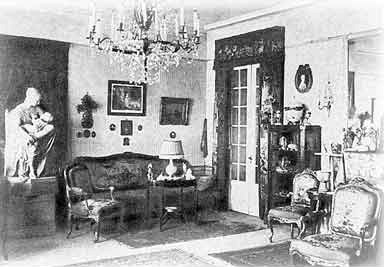

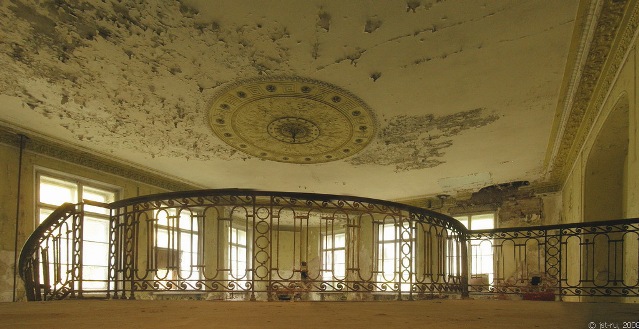
According to diaries and memories of the people who knew Agathon Faberge was a pleasant man. Despite his millions Agathon was modest and enjoyed a good company of his friends. He loved to entertain his guests and offered them his hospitality and his house. The house was alive with people. Kids usually played in the massive garden that surrounded the former estate or played hide and seek in the Winter Garden. Grown ups usually opened huge windows of the residence, ate, smoked cigars and discussed politics, women, religion and other things. In the evening they played piano that once stood in the big hall. You can even find its former location by the marks left on the rotting hardwood. All this lasted until Soviet Revolution of 1917 did not bring an end to a former life.

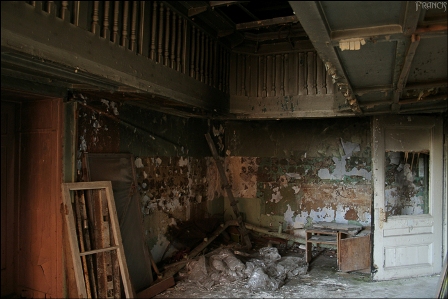
The building was reconstructed in the contemporary Art Nouveau style
under the direction of Ivan Galnbek. Contemporaries called this
place the "Small Hermitage", and all thanks to the owner's passion -
there were two unique collections here: stamps and precious stones.
In addition, the house was an excellent architectural example, and
its interiors amazed guests with richness and sophistication.
At that time, neither the owner of the estate, nor his admiring
guests could imagine that soon the comparison with the Hermitage
would seem like an evil irony. After the October Revolution, someone
writes a false denunciation of Agathon Faberge, which says that he
stole a lot of old things that adorn his dacha from the Winter
Palace. Shortly thereafter, searches and interrogations begin.
Agafon Karlovich, realizing that he and his family will not be given
a quiet life, transports his wife and children to Finland, while he
himself tries to save at least part of his collection. Soon,
according to a new denunciation, Faberge is arrested.
Former library of the Faberge residence was completely stripped by the Bolsheviks who were looking for the jewels of the former residents. Initially the missed the secret door that hid them. However they found a way to get them. Several months in a prison for the former resident of the house proofed to be enough to share a secret. We can only guess what inhumane tortures were used to get these precious jewels. Hidden room was eventually found in the library, heavy door (pictured on the right) was opened and all its riches were removed. Despite complete trashing of 1919 brother of Agathon,Eugene Faberge (1878- 1960) claimed that most of the jewels were actually hidden near the estate and commies missed most of them. Whether it is true or not we don't know. Needless to say there is no shortage of people who tried to look for these riches and failed. Or maybe kept quiet if they found anything. Regardless Agathon Faberge escaped to Finland, former province of the Russian Empire, in 1927. Soviet Secret Police chased them and even shot a former millionaire. But he escaped across the border, recovered from his gun shot and spent the rest of his life quietly and in peace.
Eugene Faberge (1878- 1960)

It is hard to believe now, but just a century ago the estate of the Faberge family was surrounded by a majestic park with fountains, beautiful trees and flowers. Some of the trees were arranged as a huge growing sun clock. The owner could simply gaze outside of his office to check what time it was.
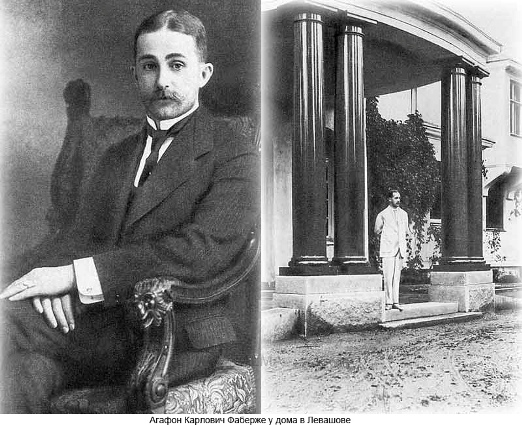
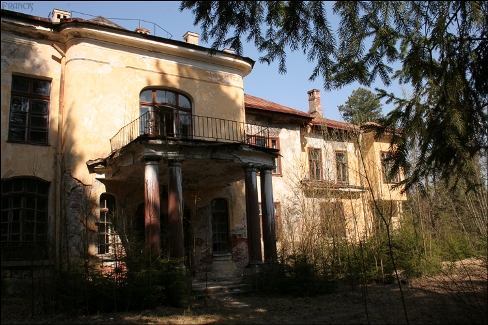
Agathon Faberge at the entrance of his residence before and after.
The fate of the house becomes obvious - it is
ruthlessly robbed, destroyed, turned into stables and pigsties. What for
some reason it was impossible to steal or seemed unnecessary to the Red
Army men and commissars was broken and destroyed. The collection of
stamps and precious stones also disappeared, but since they were hidden
in a cache, ordinary proletarians could not get to them, and everything
went to the top party leadership. What happened to these collections
after is still unknown.
During the Soviet era, there was a
sanatorium for Chekists, during the Second World War, a hospital worked,
and until 1991, a children's health garden. After being forced to work
for the Bolsheviks, Agathon Faberge managed to escape to Finland,
crossing the Gulf of Finland on the ice. The jeweler lived in the
country until 1951 and was buried in the Orthodox cemetery in Helsinki.
What to see
Today, the mansion is in a deplorable state and is
being destroyed before our eyes, although it has the status of a
monument of federal significance. All that has survived from the
interiors is a huge marble staircase, oak railings and a magnificent
tiled stove. But even in this form, one can appreciate the beauty and
grandeur of the former Faberge dacha. The outbuildings - the stable, the
carriage house, the outbuilding for the servants - are also in no better
condition than the main house. Around the mansion, there is still a once
magnificent, but now extremely neglected park.
Practical
Information
Address: Leningrad region, Levashovo, Sand highway, 14.
How to get there: Faberge's dacha is located not far from St.
Petersburg, it is no more than 25 km from the city center by car, the
journey time is about 30 minutes. By public transport: by train from the
station "Udelnaya" to "Pargolovo", then by buses No. 109, 109A and 109B
or by minibuses No. K259 and K680 to the stop "Pesochny Village".